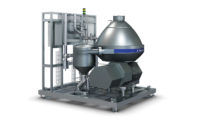
Longer Life
by Lori Dahm
Industry changes are driving the need for
extended-shelf-life dairy beverages.
American consumers have
become accustomed to the luxury of fresh, refrigerated milk as a mainstay
in their consumption habits. But that luxury is slowly eroding, as dairy
plant consolidations are altering distribution and mass-merchandiser
venues operate through strategies of non-refrigerated retailing.
The result is that dairy beverages that can be stored
at ambient temperatures and have extended shelf life are becoming top of
mind for dairy manufacturers. But these dairy products can suffer from
off-flavor notes and stability issues. So while the prospect of
shelf-stable dairy products and non-refrigerated distribution are at the
forefront of the industry, the problems that plague dairy products treated
with high heat remain an obstacle that dairy manufacturers and food
scientists are struggling to overcome.
“The science is progressing and the industry is
perfecting the existing processing technologies of extended-shelf-life
products. It is an industry learning curve and the quality is continuing to
get better on these products,” says Bill Haines, vice president of
innovation at Dairy Management Inc. (DMI), Rosemont, Ill. “University
studies and dairy plants are fine tuning the processes to achieve the best
products. And on the flip side, consumer tastes and perceptions will shift
and adapt over time, so as these products become more common, what was
perceived as a shortcoming will become more mainstream.”
Heat Treatment
Standard dairy milk products undergo HTST
pasteurization to render them safe for human consumption and reduce
bacterial populations, yet these dairy products still must be refrigerated.
Such “fresh” milk products have a shelf life of 14 to 21 days.
Many milk products today utilize HTST pasteurization coupled with hygienic
packaging processes to extend shelf life to 30 days or more.
Other options for extending the shelf life of dairy
products require higher heat treatments coupled with hygienic packaging.
For example, ultra-pasteurized (UP) products are thermally processed at 280
degrees F for two seconds and, if stored refrigerated, these dairy products
have a shelf life of up to 45 days.
Even better, if UP dairy products are hygienically
packaged using aseptic technology, these products can be shipped and stored
at refrigerated temperatures and offer a shelf life of up to three months.
However, UP temperatures are the conditions under which the taste as well
as the stability of milk beverages can begin to degrade. Some UP dairy
products can suffer from slight “cooked” notes, or can have the
milkfat components separate out over time during storage.
Another possible higher-heat treatment is
ultra-high-temperature processing (UHT), which heats milk products for four
to 15 seconds at 280 to 302 degrees. If UHT products are aseptically
packaged or retort processed, the milk products can be shipped and stored
at ambient temperatures and can offer a shelf life of six months to a year.
However, these extreme amounts of heat can result in the disadvantageous
off-flavors and stability issues that consumers find unacceptable.
The currents of today’s changing dairy world
demonstrate the need for finding a solution to these problems. Many dairy
processors and university dairy science programs are studying ways to
improve the sensory or textural characteristics of high heat treated dairy
products.
Distribution Challenges
Dairy manufacturers realize that consumers are not
ready to transition completely to shelf-stable fluid-milk beverages.
Nonetheless, simply out of necessity, there is some movement toward these
types of products.
“In dairy, Europe has always been way ahead of
America. And what we see in Europe and in other countries is that
shelf-stable, aseptically packaged dairy products have been the standard
for a long time,” says Jan Kuiper, executive vice president at Stork
Food and Dairy Systems Inc., Gainesville, Ga. “Extended-shelf-life
products are based on economics, and the United States is just beginning to
experience the small dairy cooperatives and small plants failing to
survive. As we see a concentration of dairy plants in one central location,
the resulting distribution issues will force a change to
extended-shelf-life products.”
Another factor influencing the growing need for ESL
dairy products is the growing popularity of mass merchandisers.
“Consumers are buying milk products outside of
the traditional grocery store — in club stores, dollar stores and
mass merchandisers. These channels are not around the corner from the local
dairy and in many cases the supply chain is quite a bit longer, so
aseptic-packaged ESL products are critical,” says Jeff Keller, vice
president of strategic business development at Tetra Pak Inc., Vernon
Hills, Ill. “There is a very fixed amount of chilled retail
space in these channels and so ESL dairy products are a wonderful solution
for them.”
While there may be a limit upon how willingly American
consumers will embrace unflavored fluid milk that is not refrigerated, new
innovative dairy beverages that do offer an extended shelf life are
currently making waves in the market.
In the Market
One of the biggest success stories in
extended-shelf-life dairy products is the introduction of Horizon
Organic’s single-serve, aseptic, flavored-milk products. This product
is noteworthy because the line met the needs of the intended audience, but
also happened upon an unintended and lucrative niche.
“Horizon single-serve, aseptically packaged
milks in the Tetra Prisma package have been a tremendous success in a
number of different areas. But the most interesting success has been the
solution they offered to Starbucks,” says Keller. “Most
Starbucks don’t have extra refrigerated storage, but these products
can be stored at ambient temperatures and then placed in the small cooler
out front as needed.”
Three years ago, Horizon introduced three varieties of
flavored, single-serve milk products in TetraPrisma packs. The TetraPrisma
pack is a slim 8-ounce package with an outer foil wrapper — seen as
more “adult” than a juice box.
This product line can be shipped and stored without
refrigeration, although most retailers sell the products in the
refrigerated case.
“It is common everywhere else in the world to
have six months to nine months to a year for the shelf life of a dairy
product that has been packaged aseptically,” says Keller. “And
with flavored milk that is packaged aseptically and has been on the shelf
for nine months, if you chill it down and conduct a blind taste test, the
untrained consumer could not tell the difference between that product and a
fresh milk product.”
The Horizon Organic single-serve milk product line was
also a success in natural food channels where it was sold both on the shelf
and in the refrigerated case.
And finally, the ability of Horizon’s
single-serve aseptic milks to be stored at ambient temperatures brought the
product into club stores.
“Aseptic processing is the highest grade of
hygienic filling, and together with the UHT process creates a sterile milk
product with an extended shelf life,” says Kuiper. “We make an
aseptic filler that delivers 60 to 90 days extended shelf life without
refrigeration.”
It seems that one of the keys to successful marketing
of shelf-stable fluid-milk products is education. The single-serve milks
from Horizon Organic may be so popular because the consumer audience for
these products is generally more educated about their food.
In fact, if extended-shelf-life dairy products are
going to be embraced by consumers readily, an extensive education campaign
must accompany the new products to market, since unfamiliar means of
consuming milk will not be easy for consumers to swallow.
Value-Added
The other inroad in extended-shelf-life dairy
beverages is in value-added dairy-based products.
“The UHT process results in a different taste
than fresh milk, and the American taste hasn’t adapted to it yet. But
a lot of new product activity in dairy extended shelf life includes the
flavored products or value-added dairy products, in which the consumer
doesn’t taste that sterilization effect,” says Kuiper.
“Eventually, shelf stability will prevail, which is why our business
philosophy is going that direction.”
Kuiper points to rising energy costs being another
factor propelling extended-shelf-life dairy-based products, as the energy
needed to ship and store refrigerated products will become more costly.
“The dairy category represents a category with
untapped potential for non-traditional processors, like the beverage
companies who are hearing about current consumer interest in health and
wellness,” says Haines.
The soda companies coming under fire for products with
“empty calories” might soon become competition for dairy
manufacturers. Such companies have established massive distribution systems
that could easily incorporate ESL dairy-based beverages.
Of course, working with dairy components in a beverage
product is far from simple. Just ask Dr. Phil Tong, professor of dairy
products technology at California Polytechnic University in San Luis
Obispo, Calif.
Tong is studying heat-induced changes that can affect
stability issues in various product applications, through funding from DMI
and a matching grant from the California State University Agricultural
Research Initiative. Tong’s project aims to understand and ultimately
improve the applicability of dried dairy ingredients in formulations to
create dairy-based beverages.
“We are trying to understand what contributes to
the variability of dried dairy ingredient properties and systematically
study those variations and their effects upon the stability of the beverage
system,” says Tong. “There are subtle differences in dried
dairy ingredient ratios of casein to whey proteins, which may contribute to
differences in their behavior in the presence of heat.”
Whey proteins tend to denature from heat, unfold and
create opportunities for new ingredient interactions to take place in these
systems. This causes whey proteins to gel or coagulate when they are
heated. Caseins, on the other hand, usually remain stable under very high
heat processing at the pH of milk.
Tong notes that additional components of a typical
dairy-based beverage environment — such as acid — also affect
stability. For example, the acid from a fruit juice results in a pH of 3.5
or 4, at which point casein can become less stable. Although some whey
proteins are more stable at this pH, the presence of acid can result in an
unpleasant chalky mouthfeel if not addressed properly. Typically such
dairy-based beverages must incorporate buffers and polysaccharide gums or
other stabilizers to reduce these undesired effects.
Acid environments can limit the amount of dairy
proteins that can be utilized in such environments. In addition, the impact
of acid environments may depend on the ratio of these dairy proteins to
other constituents.
“The other ratio we will vary and study in the
milk powder is the ratio of solids to protein, or lactose to protein or
protein to minerals,” says Tong.
When the protein level in milk powder is high,
stability becomes a challenge if this is not addressed.
“In the United States, we don’t control
the protein content of milk when we create milk powder; we simply remove
the fat out of fresh raw milk, pasteurize it and remove the water to dry
it. So whatever ratio of constituents are inherent in the original milk
will be the ratio of the final dried product,” says Tong. “But
now there is technology available to adjust the ratio of protein to lactose
through membrane processing. So another part of our project will document
how varying the composition of protein to lactose affects the stability of
the system.”
This is the first phase of the project. Then starts
phase two, wherein Tong will begin to study some of the commercial blends
of stabilizer and chelating agents that help improve stability in these
dairy-based beverage systems.
“Carrageenans are already present in many dairy
beverage products to stabilize the system, but they are becoming critical
in ESL products that are ambient-stored,” says Ted Benic, director of
technical services and general manager of dairy blended systems at TIC
Gums, Belcamp, Md. “As these products warm up, their viscosity drops
and they rely upon some sort of suspending agent to keep the product solids
in suspension.”
Many of the value-added dairy-based beverage products
contain vitamins and minerals, and 75 to 80 percent of these nutrients are
insoluble in a water or milk-derived environment, tending to settle out of
solution.
“The trend is to have more vitamins and
minerals. Ten percent of the RDA doesn’t cut it anymore, now we want
100 percent of the RDA in a serving,” says Benic. “This means
adding five to 10 times the normal amount of vitamins and minerals that
would exist naturally in a product, and trying to get all of this in one
product and keep them suspended.”
Carageenan also reacts with potassium, calcium and
sodium, which can be an advantage in keeping the emulsion if this effect is
accounted for in the formulation. A gelatinous mass can result if high
levels of potassium, calcium or sodium are included with carageenan without
an understanding of this synergistic effect. Sometimes sequestering agents
are used in these formulations to bind some of the calcium, sodium or
potassium to control their reaction with carageenan.
“Lecithin is used as an emulsifier to bind fats
in dairy-based beverages, eliminating the lines of separation we see in
products,” says Benic. “These are called
‘multi-phase’ products, where we are trying to get water and
oil to bind together. After these products are on the shelf for six months
the interfacial tension starts causing the emulsion to break unless
lecithin is included.”
If more than 0.1 percent lecithin is used in a
product, consumers notice an off taste, so levels of the ingredient must be
kept circumspect. And depending upon the desired foaming effects, lecithin
can be used in conjunction with mono and diglycerides (to yield more
foaming), although these ingredients are not considered natural and
sometimes are label-prohibitive.
The Forecast
For now, consumers are most willing to embrace
extended-shelf-life dairy products that are familiar — meaning
refrigerated. HP Hood LLC, Chelsea, Mass., may be the reigning expert in
this arena. HP Hood has been manufacturing refrigerated extended-shelf-life
dairy beverages for several years, including products within the
company’s licensed brands such as Lactaid, Nesquik and Coffee-Mate.
“Our extended-shelf-life products all deliver at
least 60 days shelf life. These products undergo higher-temperature
short-time treatment and are filled under environmentally controlled
systems,” says Peggy Poole, Hood’s vice president of quality.
“This filling environment is commercially sterile, with fillers that
have been hyper filtered, air that is hyper filtered and packaging
materials that have been treated to ensure sterility.”
And just in November, Hood began processing and
distributing Stonyfield Farm-branded organic milk as a new
extended-shelf-life product. This new development is generating a lot of
excitement.
“The reality is that we must stay in touch with
our consumers and their changing needs,” says Poole. “That
means we continue to monitor consumer needs so we can respond to changing
demographics and nutritional demands by developing new formulas and
introducing new, innovative products.”
$OMN_arttitle="Longer Life";?>

